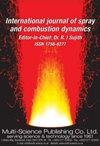Stability criteria of two-port networks, application to thermo-acoustic systems
IF 2.1
4区 工程技术
Q3 ENGINEERING, MECHANICAL
International Journal of Spray and Combustion Dynamics
Pub Date : 2022-03-01
DOI:10.1177/17568277221088465
引用次数: 0
Abstract
System theory methods are developed and applied to introduce a new analysis methodology based on the stability criteria of active two-ports, to the problem of thermo-acoustic instability in a combustion appliance. The analogy between thermo-acoustics of combustion and small-signal operation of microwave amplifiers is utilized. Notions of unconditional and conditional stabilities of an (active) two-port, representing a burner with flame, are introduced and analyzed. Unconditional stability of two-port means the absence of autonomous oscillation at any embedding of the given two-port by any passive network at the system's upstream (source) and downstream (load) sides. It has been shown that for velocity-sensitive compact burners in the limit of zero Mach number, the criteria of unconditional stability cannot be fulfilled. The analysis is performed in the spirit of a known criterion in microwave network theory, the so-called Edwards-Sinsky's criterion. Therefore, two methods have been applied to elucidate the necessary and sufficient conditions of a linear active two-port system to be conditionally stable. The first method is a new algebraic technique to prove and derive the conditional and unconditional stability criteria, and the second method is based on certain properties of Mobius (bilinear) transformations for combinations of reflection coefficients and scattering matrix of (active) two-ports. The developed framework allows formulating design requirements for the stabilization of operation of a combustion appliance via purposeful modifications of either the burner properties or/and of its acoustic embeddings. The analytical derivations have been examined in a case study to show the power of the methodology in the thermo-acoustics system application.双端口网络的稳定性准则,在热声系统中的应用
开发并应用系统论方法,针对燃烧设备中的热声不稳定性问题,提出了一种基于有源双端口稳定性准则的新分析方法。利用燃烧的热声学和微波放大器的小信号操作之间的类比。介绍并分析了以火焰燃烧器为代表的(有源)双端口燃烧器的无条件稳定性和条件稳定性的概念。双端口的无条件稳定性意味着系统上游(源)和下游(负载)侧的任何无源网络在给定双端口的任何嵌入处都不存在自主振荡。研究表明,对于速度敏感的紧凑型燃烧器,在零马赫数的极限下,不能满足无条件稳定性的标准。该分析是根据微波网络理论中的一个已知标准,即所谓的Edwards-Sinsky标准进行的。因此,应用两种方法来阐明线性有源双端口系统条件稳定的充要条件。第一种方法是一种新的代数技术,用于证明和推导条件和无条件稳定性准则;第二种方法基于(有源)两个端口的反射系数和散射矩阵组合的Mobius(双线性)变换的某些性质。所开发的框架允许通过对燃烧器特性或/和其声学嵌入的有目的的修改来制定用于燃烧设备的稳定操作的设计要求。在一个案例研究中对分析推导进行了检验,以表明该方法在热声学系统应用中的威力。
本文章由计算机程序翻译,如有差异,请以英文原文为准。
求助全文
约1分钟内获得全文
求助全文
来源期刊

International Journal of Spray and Combustion Dynamics
THERMODYNAMICS-ENGINEERING, MECHANICAL
CiteScore
2.20
自引率
12.50%
发文量
21
审稿时长
>12 weeks
期刊介绍:
International Journal of Spray and Combustion Dynamics is a peer-reviewed open access journal on fundamental and applied research in combustion and spray dynamics. Fundamental topics include advances in understanding unsteady combustion, combustion instability and noise, flame-acoustic interaction and its active and passive control, duct acoustics...
 求助内容:
求助内容: 应助结果提醒方式:
应助结果提醒方式:


